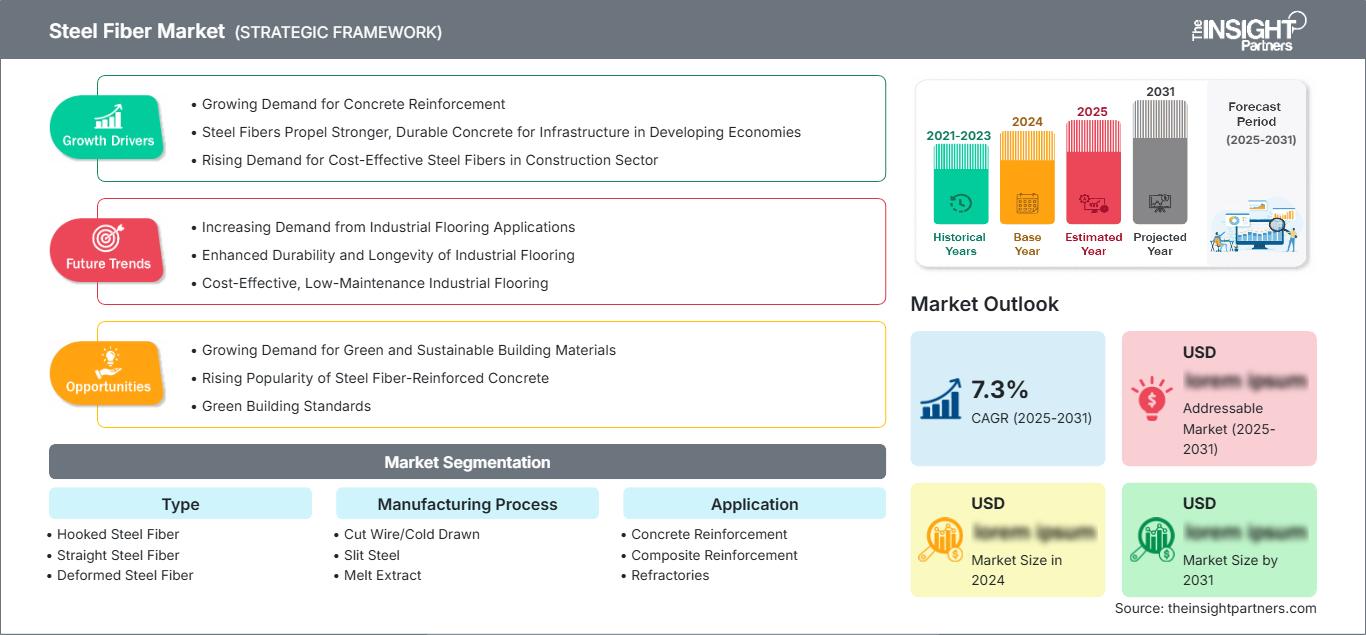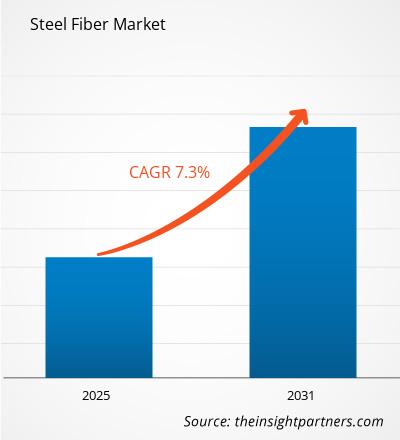Le marché de la fibre d'acier devrait enregistrer un TCAC de 7,3 % entre 2025 et 2031, avec une taille de marché passant de XX millions de dollars américains en 2024 à XX millions de dollars américains d'ici 2031.
Le rapport est segmenté par type (fibre d'acier crochetée, fibre d'acier droite, fibre d'acier déformée et autres). Le rapport est également segmenté en fonction du procédé de fabrication (fil coupé/étiré à froid, acier refendu, extrait de fusion et autres) et de l'application (renfort de béton, renfort composite, réfractaires et autres). Le rapport couvre cinq régions : Amérique du Nord, Europe, Asie-Pacifique, Moyen-Orient et Afrique, Amérique du Sud et centrale et pays clés de chaque région. L'analyse mondiale est ensuite ventilée au niveau régional et par principaux pays. Le rapport offre la valeur en USD pour l'analyse et les segments ci-dessus.
Objectif du rapport
Le rapport sur le marché de la fibre d'acier de The Insight Partners vise à décrire le paysage actuel et la croissance future, les principaux facteurs moteurs, les défis et les opportunités. Cela fournira des informations aux différentes parties prenantes de l'entreprise, telles que :
- Fournisseurs de technologies/Fabricants : Comprendre l'évolution de la dynamique du marché et connaître les opportunités de croissance potentielles, leur permettant de prendre des décisions stratégiques éclairées.
- Investisseurs : Réaliser une analyse complète des tendances concernant le taux de croissance du marché, les projections financières du marché et les opportunités qui existent tout au long de la chaîne de valeur.
- Organismes de réglementation : Réglementer les politiques et surveiller les activités du marché afin de minimiser les abus, de préserver la confiance des investisseurs et de maintenir l'intégrité et la stabilité du marché.
Type de segmentation du marché des fibres d'acier
- Fibre d'acier crochetée
- Fibre d'acier droite
- Fibre d'acier déformée
Procédé de fabrication
- Fil coupé/étiré à froid
- Acier refendu
- Extraction de fusion
Application
- Renfort du béton
- Renfort composite
- Réfractaires
Géographie
- Amérique du Nord
- Europe
- Asie-Pacifique
- Amérique du Sud et centrale
- Moyen-Orient et Afrique
Vous bénéficierez d’une personnalisation sur n’importe quel rapport - gratuitement - y compris des parties de ce rapport, ou une analyse au niveau du pays, un pack de données Excel, ainsi que de profiter d’offres exceptionnelles et de réductions pour les start-ups et les universités
Marché des fibres d'acier: Perspectives stratégiques

-
Obtenez les principales tendances clés du marché de ce rapport.Cet échantillon GRATUIT comprendra une analyse de données, allant des tendances du marché aux estimations et prévisions.
Moteurs de croissance du marché des fibres d'acier
- Demande croissante de renforcement du béton : La demande croissante de barres d'armature pour le béton par les entreprises de construction stimule le marché des fibres d'acier. Les fibres d'acier ont de nombreuses applications pour améliorer les propriétés de traction, la durabilité et la résistance aux fissures du béton. L'utilisation des fibres d'acier s'accroît parallèlement à la croissance des infrastructures dans le monde.
- Les fibres d'acier propulsent un béton plus résistant et durable pour les infrastructures des économies en développement : En ce qui concerne la construction, en particulier dans les économies en développement, la demande de béton plus résistant et plus robuste est élevée. Les fibres d'acier dans des applications critiques comme les ponts, les autoroutes et les sols industriels, qui nécessitent une plus grande capacité de charge et une meilleure résistance à la fissuration, augmentent encore la quantité de matériau nécessaire. Par conséquent, cette tendance favorise l'utilisation accrue des fibres d'acier dans la construction.
- Demande croissante de fibres d'acier rentables dans le secteur de la construction : De plus, les fibres d'acier sont beaucoup moins chères et efficaces que les formes conventionnelles de barres d'armature. Faciles à intégrer dans le béton et offrant des coûts d'entretien et de réparation réduits, leur adoption est en plein essor. Grâce à ces avantages, le marché des fibres d'acier va croître parallèlement à la demande croissante dans le secteur de la construction.
Tendances futures du marché des fibres d'acier
- Demande croissante pour les revêtements de sol industriels : L'une des principales tendances du marché des fibres d'acier est leur adoption croissante dans les revêtements de sol industriels. Les fibres d'acier améliorent la résistance, la durabilité et la résistance aux fissures du béton lorsqu'elles sont utilisées dans des environnements à fort trafic et à forte charge, tels que les usines, les entrepôts et les centres de distribution.
- Durabilité et longévité accrues des revêtements de sol industriels : Les machines lourdes travaillent en permanence sur les sols industriels, déplaçant des marchandises d'un point à un autre et exposant les surfaces en béton à différentes influences environnementales. Les propriétés du béton sont moins performantes en matière de fissuration, en raison d'une meilleure répartition des charges et d'une durée de vie accrue des revêtements de sol. Cela justifie le choix des fibres d'acier pour les applications de construction industrielle.
- Revêtements de sol industriels économiques et nécessitant peu d'entretien : La demande croissante de solutions de revêtement de sol économiques et nécessitant peu d'entretien est une tendance supplémentaire. Le renforcement du béton avec des fibres d'acier élimine le besoin de renforcement traditionnel comme les barres d'armature, réduisant ainsi les coûts des matériaux et le temps de main-d'œuvre. Avec l'expansion des industries qui crée une demande accrue de systèmes de revêtements de sol plus robustes, l'utilisation de fibres d'acier dans les revêtements de sol industriels va probablement augmenter, accélérant ainsi la croissance du marché.
Opportunités du marché des fibres d'acier
- Demande croissante de matériaux de construction écologiques et durables : Le marché des fibres d'acier présente un potentiel de croissance important en raison de la demande croissante de matériaux de construction écologiques et durables. Avec l'évolution des tendances du secteur de la construction vers des initiatives environnementales, le béton renforcé de fibres d'acier (SFRC) a été cité comme une meilleure option écologiquement durable que le béton traditionnel pour le renforcement. Il améliore également les performances.
- Popularité croissante du béton fibré : Le béton fibré est produit avec une faible consommation d’énergie et s’intègre généralement dans des projets engagés en faveur du développement durable. Les fibres d’acier tendent à renforcer la résistance du béton, réduisant ainsi les besoins d’entretien et prolongeant la durée de vie des structures, ce qui contribue à la réduction de l’empreinte carbone à l’échelle mondiale pour des solutions de construction durables et respectueuses de l’environnement.
- Normes de construction écologique : Outre l’accréditation gouvernementale, les organisations privées établissent désormais leurs propres certifications et normes pour les bâtiments écologiques afin de garantir la durabilité de leurs projets. Cependant, ces développements devraient aboutir à une demande croissante de bétons fibrés ; de nouvelles opportunités d’innovation et de développement du marché pour les fabricants permettront de découvrir de nouveaux secteurs propices au développement durable.
Marché de la fibre d'acier
Les tendances régionales et les facteurs influençant le marché de la fibre d'acier tout au long de la période de prévision ont été analysés en détail par les analystes de The Insight Partners. Cette section aborde également les segments et la géographie du marché de la fibre d'acier en Amérique du Nord, en Europe, en Asie-Pacifique, au Moyen-Orient et en Afrique, ainsi qu'en Amérique du Sud et en Amérique centrale.Portée du rapport sur le marché des fibres d'acier| Attribut de rapport | Détails |
|---|---|
| Taille du marché en 2024 | US$ XX million |
| Taille du marché par 2031 | US$ XX Million |
| TCAC mondial (2025 - 2031) | 7.3% |
| Données historiques | 2021-2023 |
| Période de prévision | 2025-2031 |
| Segments couverts |
By Type
|
| Régions et pays couverts |
Amérique du Nord
|
| Leaders du marché et profils d'entreprises clés |
|
Densité des acteurs du marché de la fibre d'acier : comprendre son impact sur la dynamique des entreprises
Le marché de la fibre d'acier connaît une croissance rapide, portée par une demande croissante des utilisateurs finaux, due à des facteurs tels que l'évolution des préférences des consommateurs, les avancées technologiques et une meilleure connaissance des avantages du produit. Face à cette demande croissante, les entreprises élargissent leur offre, innovent pour répondre aux besoins des consommateurs et capitalisent sur les nouvelles tendances, ce qui alimente la croissance du marché.
- Obtenez le Marché des fibres d'acier Aperçu des principaux acteurs clés
Principaux arguments de vente
- Couverture exhaustive : Le rapport couvre l’analyse exhaustive des produits, services, types et utilisateurs finaux du marché de la fibre d’acier, offrant un panorama global.
- Analyse d’experts : Le rapport est élaboré à partir d’une compréhension approfondie des experts et analystes du secteur.
- Informations actualisées : Le rapport garantit la pertinence commerciale grâce à sa couverture des informations récentes et des tendances des données.
- Options de personnalisation : Ce rapport peut être personnalisé pour répondre aux besoins spécifiques des clients et s’adapter aux stratégies commerciales.
Le rapport de recherche sur le marché de la fibre d’acier peut donc contribuer à la compréhension du marché et des perspectives de croissance. Malgré quelques préoccupations légitimes, les avantages globaux de ce rapport tendent à l’emporter sur les inconvénients.
- Analyse historique (2 ans), année de base, prévision (7 ans) avec TCAC
- Analyse PEST et SWOT
- Taille du marché Valeur / Volume - Mondial, Régional, Pays
- Industrie et paysage concurrentiel
- Ensemble de données Excel
Rapports récents
Rapports connexes
Témoignages
Raison d'acheter
- Prise de décision éclairée
- Compréhension de la dynamique du marché
- Analyse concurrentielle
- Connaissances clients
- Prévisions de marché
- Atténuation des risques
- Planification stratégique
- Justification des investissements
- Identification des marchés émergents
- Amélioration des stratégies marketing
- Amélioration de l'efficacité opérationnelle
- Alignement sur les tendances réglementaires






















 Obtenez un échantillon gratuit pour - Marché des fibres d'acier
Obtenez un échantillon gratuit pour - Marché des fibres d'acier